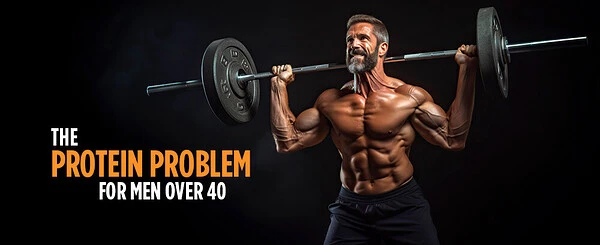The Protein Problem for Men Over 40
As one ages, the efficiency of protein utilization deteriorates. This article delves into the underlying causes and offers practical solutions.
The Unfortunate Reality
Here's some rather disheartening news: around the early 40s, the body's capacity to build muscle begins a gradual decline. This phenomenon, known as age - related anabolic resistance, is closely associated with muscle protein synthesis. This is the crucial process through which the body generates new proteins to repair and develop muscle tissue.
Underlying Causes
Muscle Cell Signaling Alterations: Changes occur in muscle cell signaling pathways, such as the mTOR pathway.
Hormonal Shifts: Hormonal imbalances, including reduced insulin sensitivity, play a role.
Low - grade Inflammation: Chronic low - grade inflammation contributes to this condition.
Thankfully, many individuals are already taking preventive measures, like engaging in resistance training, avoiding excessive fat accumulation, and reducing inflammation through fish oil supplementation.
However, age - related anabolic resistance also dampens the body's responsiveness to dietary protein. For instance, the mTOR pathway becomes less sensitive to amino acids, particularly leucine, thus weakening the muscle's anabolic response to protein. Additionally, aging muscles experience decreased blood flow, which restricts the post - meal delivery of amino acids to muscle cells. Moreover, increased splanchnic sequestration means that the gut and liver retain more amino acids, leaving fewer available for muscle utilization.
If we neglect to address anabolic resistance in our 40s, there's a risk of becoming frail and weak in our 50s or 60s. Recently, experts in the Proceedings of the Nutrition Society made a straightforward recommendation: increase protein intake with age. Nevertheless, their advice was not specifically tailored to lifters and athletes. Let's first examine their findings and then adapt them for those aiming to maintain substantial muscle mass over the long term.
The Review
In the review published by the Cambridge University Press, the authors emphasized that individuals aged 40 and above need more protein to counter age - related anabolic resistance and support metabolic health and muscle preservation.
They pointed out that the Recommended Dietary Allowance (RDA) of 0.8g/kg/day is intended to prevent deficiency but may not be sufficient to optimize muscle health in older adults. In essence, they recommended a minimum of 1.0g/kg/day, and likely even more.
Let's convert these to American measurements:
RDA Recommendations: 0.36 g/lb/day. So, a 200 - pound man should consume 72 grams of protein daily.
Review Recommendations: >0.45 g/lb/day. A 200 - pound man should aim for 90 grams of protein daily or more. Assuming a three - meal - a - day diet, they also suggested consuming 25 - 30 grams of protein per meal. Using the example of a 200 - pound male, this amounts to only an additional 18 grams of protein per day.
You may be skeptical of these seemingly modest figures. However, considering that nutrition "experts" have long downplayed protein intake, this is at least a positive step forward. And there are valuable lessons to be gleaned.
Applications for Lifters
The review's authors did highlight several crucial aspects. For example, age - related anabolic resistance commences as early as the 40s and worsens over time if preventive steps are not taken. This can potentially lead to sarcopenia.
It's also notable that the aging body is less efficient in "utilizing" protein. The solution to the protein - utilization problem is relatively straightforward: consume even more protein than before and perhaps opt for superior protein/amino sources, such as:
Casein Hydrolysate: Recognized as the most anabolic protein, it is pre - broken down into highly structured peptides. These peptides can directly penetrate muscle tissue, enabling nearly instantaneous absorption and utilization. Age - related anabolic resistance has little impact on it. It's estimated that 20 grams of casein hydrolysate can stimulate more muscle growth than 30 or 40 grams of conventional protein. Each serving of MAG - 10 (available for purchase on Amazon) contains 20 grams of PeptoPro casein hydrolysate highly structured peptides. Peptopro is a specialized form of casein hydrolysate optimized for sports performance.
Leucine: Considered the primary amino acid for muscle building, leucine also has muscle - sparing and fat - burning properties. It even enhances insulin sensitivity, one of the factors contributing to anabolic resistance. The average non - lifter may get by with around 3 grams of leucine daily, but lifters should aim for 5 grams or more. Most meats contain 2.5 to 3.5 grams of leucine per 100 - gram serving. Our workout drink, Surge Performance Fuel (available on Amazon), contains 5 grams of leucine per serving.
Whey Protein Isolate and Casein: These are also excellent sources of leucine. Thirty grams of whey isolate contains approximately 3 grams of leucine. Casein is a complete protein, containing all essential amino acids, including leucine. Look for a general - use protein powder that contains both, like MD Protein (available on Amazon).
As a general guideline, men over 40 should consider increasing their protein intake by at least 20 grams per day.
Reference
- Morgan, et al. Dietary protein recommendations to support healthy muscle ageing in the 21st century and beyond: considerations and future directions. Proceedings of the Nutrition Society, Cambridge University Press: 11 October 2023.
Age-Related Anabolic Resistance and You
•
Author: Flint
•
fitness
sport
life

Share this article
